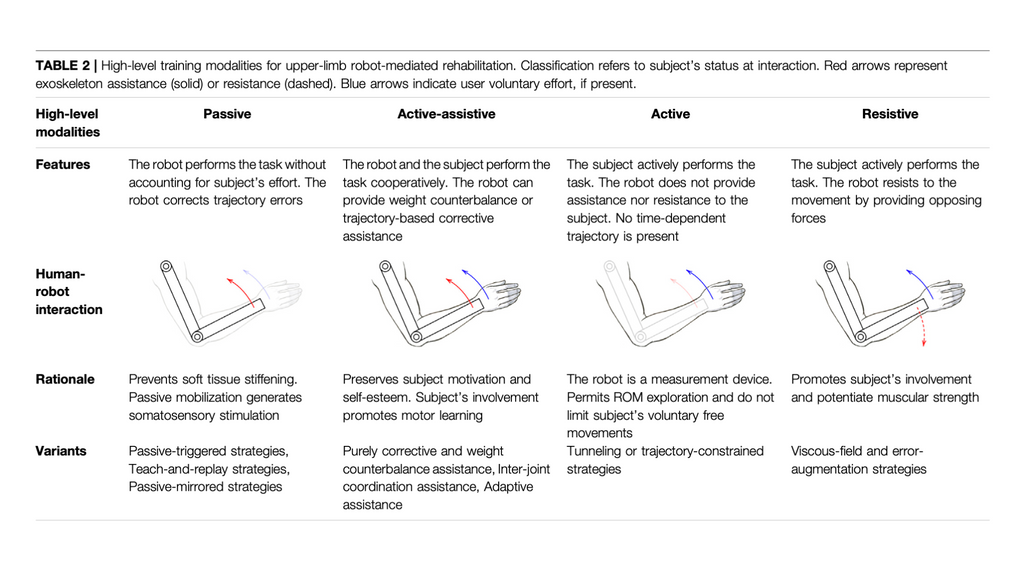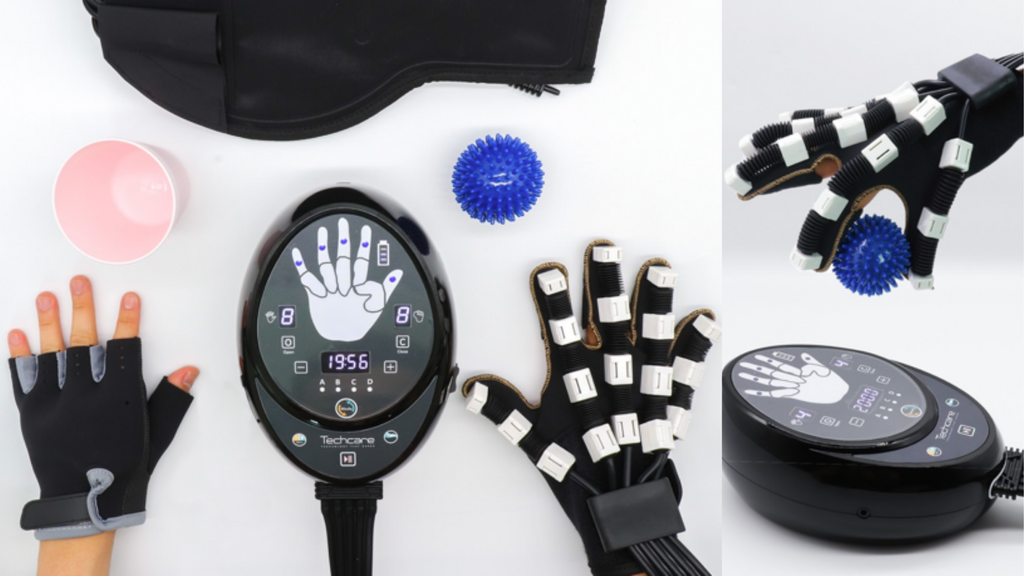What are Hand Rehabilitation Robots?
Hand rehabilitation robots are a form of robotic technology designed to assist with hand rehabilitation. They promote neuro-plasticity by providing targeted, intensive, and repetitive motor training. These robots help guide the hand through diverse exercises, improving movement and restoring strength and dexterity (Peduzzi, 2010).
Why Hand Rehabilitation Robot ?
In today's medical landscape, the demand for efficient, targeted, and intensive rehabilitation is greater than ever. Physical rehabilitation is based on the key concept of neuro-plasticity; in which repetitive exercises in rehabilitation reinforce and strengthen new neural pathways to help patient regaining the movement and function.
In a studies on neuro-plasticity after stroke, it was shown that 400-600 repetitions per day of challenging functional tasks can lead to changes in the brain. However, the average therapy session for upper limb rehabilitation only about 32 repetitions (Lang, 2009).
Besides, in view at upper limb component such as elbow, shoulder, wrist, forearm, and finger. The human hand will take the most time to rehabilitate. One of the main reason is hand have the most joints with total of 15 joints itself comparing with other upper limb component, making it the most time consuming rehabilitation process with the fine motor control and training.
Thus, the use of hand rehabilitation robot is crucial to speedup the recovery of hand function especially in neurological patient such as stroke and traumatic brain injury (TBI) as hand robotic able to perform thousand of training repetition in a single session (Flynn, 2020).
Here's some of the reason why robotic technology can be incorporated into the recovery of hand rehabilitation :
Consistency : Robots offer consistent movements, ensuring that exercises are carried out with the exactness necessary for optimal recovery.
High Repetition & Intensity: One of the keys to effective hand rehabilitation is repetitive motion. Robots can provide high-intensity exercises with the necessary repetition without tiring, ensuring that the rehab process is thorough.
Personalized Therapy: Advanced robotics can adapt and offer personalized therapy sessions based on individual patient needs, ensuring that each session is as effective as possible.
Addressing Limited Manpower: In many settings, there's a shortage of trained therapists. Robots can fill this gap, providing patients with the intensive therapy they need even in the absence of human professionals.
How Do Hand Rehabilitation Robot Works?
Hand rehabilitation robots are a synergy of biomechanics, neuroscience, and robotics. At their core, they are designed to facilitate and enhance the process of hand recovery following injuries or medical conditions. The main concept of the hand rehabilitation robot is to assist the the movement for the patient.
Type of Rehabilitation Robot
Generally, there are 2 type of hand rehabilitation robot which are exoskeleton and end effector (Gassert, 2018).
Exoskeleton Rehabilitation Robot : An exoskeleton is a wearable device that wraps around or attaches to parts of the body (like the arm, hand, or leg) and moves with the user. It is designed to support, enhance, or augment the wearer's movements. In rehabilitation, it assists weakened muscles and joints, helping restore movement. Often encompasses the entire limb or body part.
End-Effector Rehabilitation Robot: In robotics, an end-effector refers to the device at the end of a robotic arm designed to interact with the environment. It's essentially the "hand" of the robot. In the context of rehabilitation, end-effector devices grab or hold onto a patient's limb and guide it through specific motions. They work on the limb's endpoint rather than supporting its entire structure. It focuses on the point of interaction (e.g., hand or foot) rather than the entire limb.

While both exoskeletons and end-effectors play pivotal roles in rehab robotics, they target different aspects of movement and support. Exoskeletons are more comprehensive, offering support to the entire limb, whereas end-effectors are primarily concerned with the interaction point, guiding the end of the limb through specific therapeutic movements.
Training Mode of Rehabilitation Robot
In rehabilitation robot, there are different type of training mode. Here are 4 common type of training mode which are passive, active-assistive, active and resistive mode. (Gasperina, 2021)
Passive Mode: In this mode, the rehabilitation robot moves the patient's limb entirely on its own without any active effort from the patient. This mode is particularly beneficial for patients who have minimal to no voluntary muscle control. It helps maintain joint flexibility, promotes blood circulation, and prevents muscle atrophy. For example, a post-stroke patient with no hand movement might have their fingers and wrist moved by the robot to maintain joint health.
Active-Assistive Mode : Here, the robot provides assistance only when needed. The patient initiates and performs most of the movement, but if they struggle or cannot complete it, the robot assists to ensure the motion is finished. This mode encourages voluntary muscle activation and participation from the patient, making it perfect for those who can initiate movement but might not have the strength or coordination to complete it. For example, a patient trying to make a gripping motion might start the action, and if they can't complete it, the robot helps close the gap.
Active Mode: In active mode, the patient performs the movement entirely on their own without any robotic assistance. The robot is present only to monitor and provide feedback but doesn't aid in the motion. Suitable for patients who have regained significant muscle control and need to practice and reinforce their movements. The focus here is on improving coordination, strength, and precision. For example, a patient practices picking up objects or making specific hand gestures. The robot observes and might give feedback on accuracy or speed but doesn't intervene in the action.
Resistive Mode: As the name suggests, in this mode, the robot provides resistance against the patient's movements. This mode is designed to build strength by making the movement more challenging. It's ideal for patients who have moved beyond basic motion relearning and are now in the strengthening phase of their rehabilitation. For exmaple, a patient tries to extend their fingers, but the robot pushes gently against them, making the patient exert more force to complete the motion.

Each of these modes plays a crucial role in the rehabilitation journey, allowing for a tailored approach that can be adapted as the patient progresses and regains function.
Limitation of Hand Rehabilitation Robot
While hand rehabilitation robots offer numerous benefits and have significantly advanced the field of physical therapy, they also come with their own set of limitations.
Cost of Acquisition : Acquiring and maintaining robotic systems may be expensive, which might limit their accessibility in certain settings.
Not a Magic Pill : While robots offer many benefits, the robot rehabilitation training is not a magic pill for all the recovery. Patient still need the facilitation from therapist to ensure the training is best suits the their recovery in combination with conventional therapy.
Dependence on Technology: There's a potential risk that patients might become overly reliant on the robot for movement, leading to decreased motivation to engage their own muscles.
Training and Specialisation:
Using and maintaining these robots often requires professional specialized training. The limited trained professional may limit the potential of robotic technology for optimal outcome of the patient
Clinical Evidence of Hand Rehabilitation Robot
Clinical evidence has been mounting in support of using hand rehabilitation robots in therapy settings, primarily due to technological advancements and the increased focus on neurorehabilitation. Here's a summary of the clinical evidence:
Improved Motor Recovery: Various studies have indicated that patients using hand rehabilitation robots show improved motor recovery compared to conventional therapy alone. This is due to the robots' ability to provide consistent, repetitive, and high-intensity exercises, which are crucial for promoting neuroplasticity after neurological injuries. (Germanotta et al., 2020; Shi, 2021; Vanoglio, 2017)
Increased Repetition: Clinical studies have emphasized the importance of repetitive tasks in neurorehabilitation. Hand rehabilitation robots can provide thousands of repetitions in a session, far exceeding what's possible in standard manual therapy (Flynn, 2020)
Optimal Combination Therapy : Research indicates that combining robotic therapy with conventional manual therapy can yield better results than either approach alone. The robots can handle repetitive tasks, while therapists focus on complex functional tasks and provide the necessary human touch (Lee, 2018).
Chronic Patients: Some evidence suggests that even chronic stroke patients, who have passed the initial recovery phase, can benefit from robotic hand rehabilitation, experiencing improvements in hand function and strength (Bressi, 2023; Cramer, 2007).
While many studies show positive outcomes, there are also findings that indicate that robotic therapy should be used judiciously. The efficacy can vary based on the type and severity of the injury, patient age, and other factors.
There are many research evidences in showing rehabilitation robot is safe and feasible to be used in improving upper limb recovery. Recent systematic review shows the rehabilitation assisted by robotic devices is recommended to improve upper limb motor function and strength.
American Stroke Association stated robot-assisted movement training for improving motor function and mobility after stroke in combination with conventional therapy may be considered and robotic therapy is reasonable to consider to deliver more intensive practice for individual with moderate to severe upper limb paresis with level A clinical evidence. (Morone, 2021)

With the high repetitive training and personalied training that suitable for each patient, it can help to speed up the recovery of the patient especially during golden period. It's worth noting that the while a lot of research supports the benefits of hand rehabilitation robots, there is still a need of continuous for larger, well-designed randomized controlled trials to provide a clearer picture of the benefits, limitations, and best practices associated with robotic therapy.
Who is Suitable to Use Hand Rehabilitation Robot?
Hand rehabilitation robots are primarily designed for individuals who have suffered hand impairments due to various reasons. Here is a list of potential candidates who might benefit from using hand rehabilitation robots:
Stroke Survivors: A significant number of stroke survivors experience hand and arm dysfunction. Rehabilitation robots can help improve motor control, strength, and dexterity in these individuals.
Traumatic Brain Injury (TBI) Patients: Those who have suffered a traumatic brain injury might face challenges in hand movement and coordination. Robots can aid in regaining lost function.
Spinal Cord Injury Patients: Patients with injuries to the spinal cord, especially in the cervical region, might benefit from robot-assisted therapy to restore hand function.
Post-surgical Patients: Individuals recovering from surgeries involving the hand or upper limb might utilize rehabilitation robots to speed up recovery and ensure proper healing. Individuals with fractures, ligament injuries, or other orthopedic conditions of the hand might use robotic systems as part of their rehab process.
Neurological Disorders: Patients with conditions like Parkinson’s disease, multiple sclerosis, or cerebral palsy might find robotic therapy beneficial in maintaining or improving hand function.
Elderly Patients with Degenerative Disorders: Conditions like osteoarthritis or rheumatoid arthritis can affect hand function in older adults. Robotic rehab can help in maintaining joint movement and reducing pain.
Individuals with Muscle Wasting Diseases: Conditions like muscular dystrophy or ALS that lead to muscle weakening can potentially benefit from robotic assistance to maintain hand functionality as much as possible.

For optimal recovery, it's recommended that patients begin their rehabilitation as soon as possible. It's essential to understand that while many can benefit from robot-assisted hand rehabilitation, however it's not suitable for everyone. Some contraindications might include severe spasticity, uncontrolled medical conditions, or certain types of fractures and wounds.
Before starting robotic therapy, a thorough evaluation by a rehabilitation specialist or physiotherapist is crucial to determine the best course of action tailored to the individual's specific needs. Utilizing these robots without proper supervision could potentially hinder recovery outcomes and raise safety concerns.
Where to Look for Hand Rehabilitation Robot?
If you're considering the use of a hand rehabilitation robot, there are several avenues you can explore to find the right one for your needs:
Rehabilitation Centers/Hospitals: Many advanced rehabilitation centers and hospitals are equipped with robotic devices for hand rehabilitation. Consulting with these institutions can give you access to these robots and, importantly, the expertise of trained professionals who can guide their use.
Trusted Supplier or Manufacturers' Websites: Companies in the field of rehabilitation robotics have trained professional and detailed information about their products on their websites. By exploring these, you can get insights into the features, benefits, and clinical evidence supporting each robot.
Recommendations from Healthcare Professionals: Your physiotherapist, occupational therapist, or doctor might be aware of the best robotic devices in the market and could provide recommendations based on your specific needs.
If your health institution or family members considering to get the medical-grade rehabilitation robot, you can talk to Techcare Innovation. Techcare Innovation is a human technology company with 10 years of experience in the field.
They are also the manufacturer of Techcare Hand Robot; which is a leading MDA certified medical-grade hand rehabilitation robot in Malaysia suitable to be used for professionals and patient at home.
The unique of the robot is able to cover 6 recovery stage from early to later stage using multiple training modes with over 20+ training configuration allowing you to adjust your therapy program for the best outcome.

For more information, about Techcare Hand Robot you can click here. Before purchase, kindly contact our product specialist here for more detail.
Conclusion
While traditional hand rehabilitation methods have their merits and continue to be invaluable, robotic rehabilitation introduces several advantages that can significantly enhance the recovery process. By integrating robotics into the rehabilitation landscape, we can offer patients a blend of human touch and technological precision, paving the way for more efficient, engaging, and effective recovery journeys.

